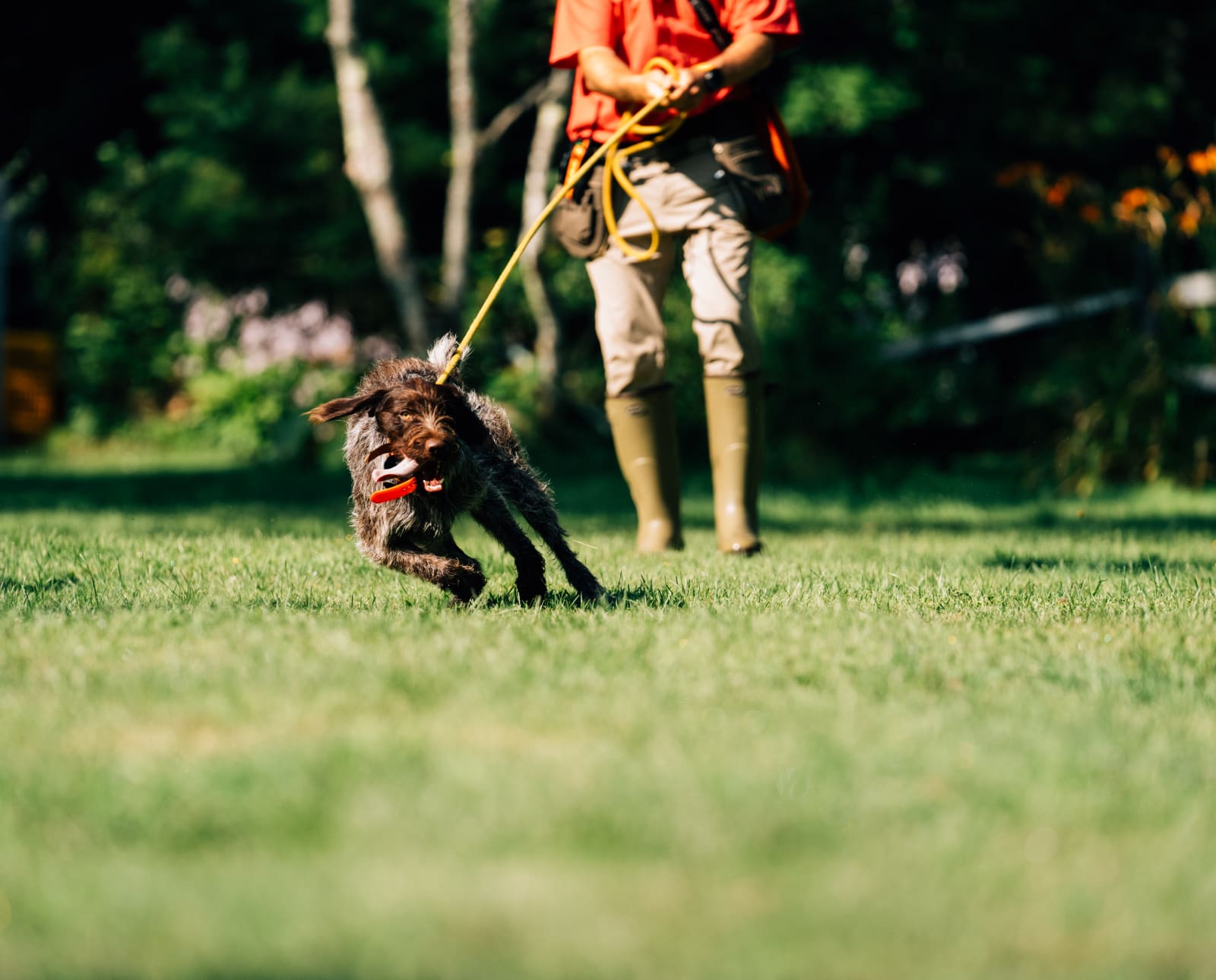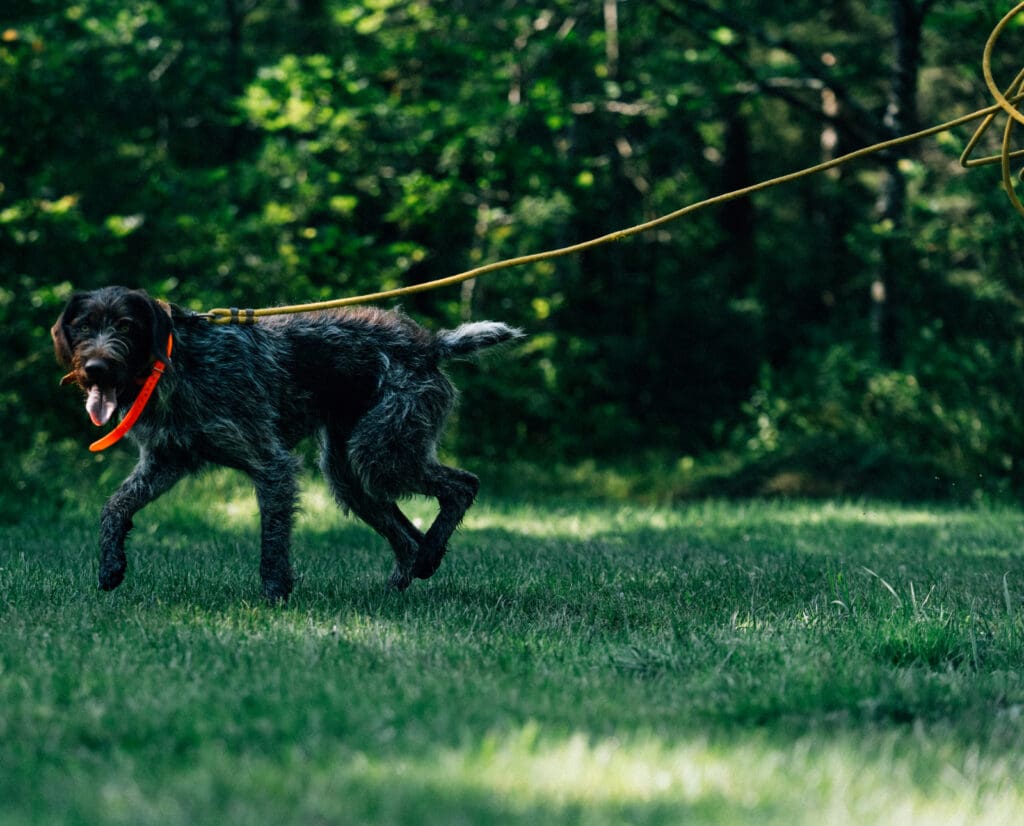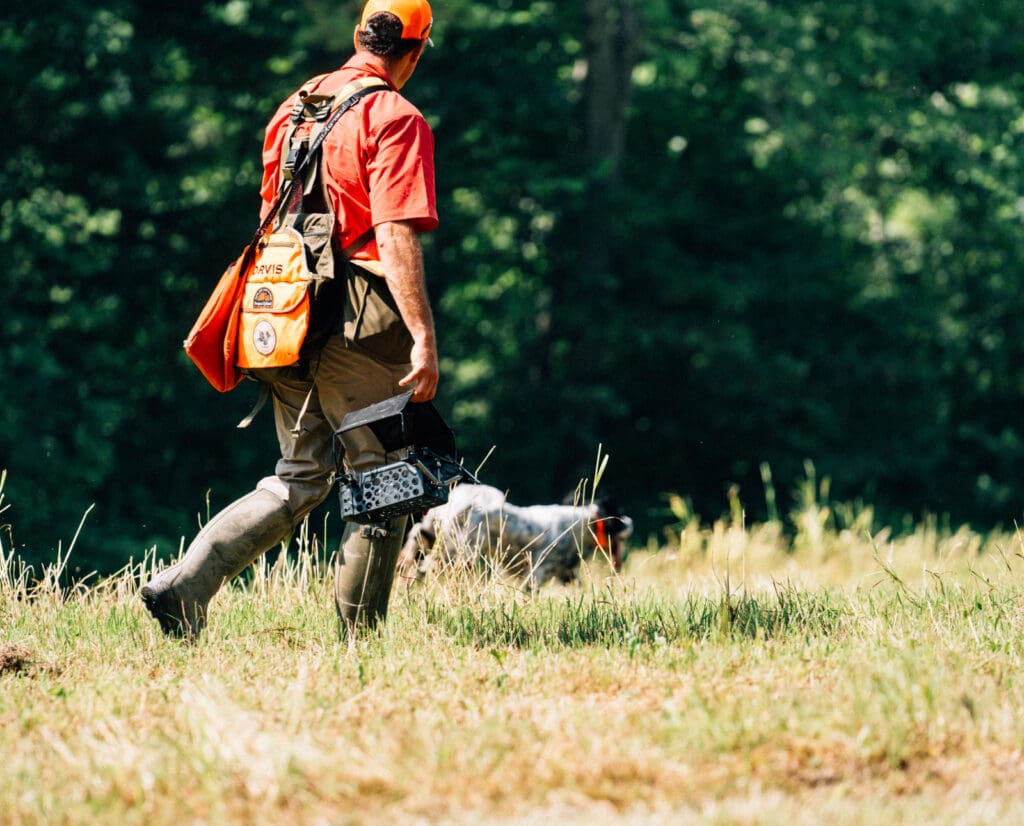Home » Hunting Dogs » Developing a Hunting Dog’s Bird Searching and Quartering Skills
Developing a Hunting Dog’s Bird Searching and Quartering Skills

Jason Carter is a NAVHDA judge, NADKC member, director of…
Using a short and long lead to train your dog how to quarter at home and in the field.
Have you ever hunted over a dog with a sixth sense for finding birds? Perhaps the dog had a higher-than-average drive to push out to find game. Or maybe it was highly intelligent and sought the most productive cover. Its exceptional nose could’ve been dialed in. Regardless of the attribute, it must have had a cooperative temperament, trusted its handler’s leadership, and would follow them to the ends of the world.
Listen to more articles on Apple | Google | Spotify | Audible
The culmination of all of these characteristics creates a legendary hunting dog. However, the dog knows how to search for a cover in a manner that leaves little opportunity for birds to be missed outperforms all other dogs.
Developing this level of teamwork starts with a dog willing to hunt for and with you. For me, this begins through teaching it to quarter with the long lead starting at a young age.

Teaching Quartering to Adolescent Dogs
Many folks struggle with their pup’s cooperation and obedience around five to ten months of age. It’s a period when the pup has grown to enjoy its freedom, yet it’s too young to transition to the e-collar. These adolescent pups enjoy testing your line of control and present an uncomfortable division in partnership.
The long lead can help with these in-between times by teaching the dog how to quarter, or search back and forth across a field. Quartering provides a good example of how the long lead can develop transitional understanding from on to off-lead handling. It follows the process of shaping behavior through chaining lessons together, leading the dog to want to work for us before using an e-collar.
First, start in the yard or another confined space to introduce the visual and verbal cues you will use in the field. Often referred to as shortgrass training or yardwork, the preliminary understanding of field commands and how to quarter must first happen away from bird scent and on familiar or sterile grounds, such as your yard.
Training sessions will start with the short lead and eventually progress to the long. Every training exercise should have a definitive beginning and end so the dog knows when it’s time to work and when it is finished. My field command to start a search is “hunt-em-up.” The search ends after the dog returns to the heel position, and I give the “free” command.
You will need to train your own verbal and whistle commands that provide you with control when out hunting. These commands take time to develop and must be in place before you can safely release your dog. For example, “come around” is a command used while the dog and handler are working a field. To command a dog to “come around,” I provide the visual of an outstretched arm with an open hand in the direction I want the dog to travel. My verbal command is “come around,” and my whistle command is one sharp blast, which means move in my direction while continuing to hunt.
Some examples of verbal commands include:
- Come Around: The dog adjusts its search to your line of travel
- Up Front: Commanding the dog to hunt ahead of you
- Leave It: Leave off scent focus and return to the hunt
- Come: Recall to a finish at your side (preferably your non-gun-carrying side)
- Hunt-em-up: Go search
- Free: The dog is free to do as it wishes
Some examples of whistle commands include:
- One quick, short whistle: Change direction with the handler.
- One long blast: Stop or a whoa command, meaning stop, look, and listen
- Two or more quick blasts of the whistle with the handler standing in a recall position: The dog comes into a finish position at the front or side of the handler.
Short Grass Short Lead Development
Developing a dog that quarters well requires well-timed physical connections and verbal commands. The lead pop is initially done only to gain the pup’s attention before delivering the command. Fortunately, on a short lead, the pup can’t gain too much momentum before hitting the end of the lead. You want a gentle pop as you move in the opposite direction as if to say, “Hey, look what’s over here.”
Directly after the gentle pop, get low, clap your hands, pick up speed, stretch out your arm, and get the pup to move excitedly in a new direction with “come around.” Get a few repetitions in, and then call it a day. Repeat this lesson every day until you see the pup paying closer attention to your movements before hitting the end of the lead. Mark that behavior with an excited “come around,” yes, or good dog. This encourages the pup to repeat the behavior and places a positive association with both the command and the lead.
If the pup starts to anticipate your change in direction, it’s time to place the verbal command before the dog hits the end of the lead. Note that your training sessions should be kept very short as learning happens fast, and you want to leave the pup wanting more.
While holding the end of the short lead, the pup should be released with excitement and will hopefully charge out into the yard, eager to search. Wearing gloves will be important because you will remain attached to the lead throughout the run. Again, encourage the pup to cast right and left using high, excited tones that build drive. Say the command “come around” in a way that motivates and excites the pup to move in your direction. It’s important to exaggerate arm movements and body positioning so your visual appearance consistently cues the dog to come around.
The pup’s first step in your direction should be marked with affirmation and lavish praise. If the dog distracts or refuses, cinch up on the lead and gently pop the collar while excitedly encouraging it to head your way.
As the pup crosses past you, turn in the opposite direction. Before it hits the end of the lead, give it another “come around” command with praise. Your goal is to develop a rhythmic pattern of movement where the dog anticipates your change in direction before hitting the end of the lead.
Once the pup is casting with your movements and verbal commands, it’s time to add the whistle. Be sure to paint the same picture. You’re simply adding a whistle before your verbal commands while maintaining the same familiar visuals. Once the pup is up to speed, begin to fade the verbal and visual commands following the whistle. If done properly, the whistle alone will eagerly turn your dog in your direction. Eventually, the act of changing direction will cause the pup to alter its movements. It’s now time to grow your control toward the end of the long lead following the same process.
Short Grass Long Lead Development
With a long lead, your dog feels more free, moving with an increased velocity for greater distances. This increased sense of independence comes with excitement and higher drive. Be careful to manage the lead in a way that keeps both you and your dog upright and injury-free. A small yard helps you and your dog get up to speed because it overlays the short lead understanding while giving you time to figure out how to manage the long line best.
It won’t be long before the dog realizes you can maintain control at a greater distance. When that feeling clicks, it’s time to proof your dog training on new grounds in a bigger field.

Proofing Your Short and Long Lead Training in Long Grass
When transitioning onto new grounds, be prepared to meet a new dog. The novel venue will cause a spike in excitement from your dog. Again, remember your yard work, and paint the same picture you did at home by starting with the short lead and progressing out to the long.
Resist the urge to let go of the lead at this point, as it could teach your dog the keep-away game. If this occurs, don’t yell or call your dog. Throw your hat in the air to imitate a bird, or flap it on the ground. The dog will want to investigate, allowing you to get ahold of the lead again. This trick may work once or twice before the dog figures it out. Hopefully, you won’t make the same mistake again.
Once you get your dog quartering nicely with just your change in direction, it’s time to proof your work with bird scent.
The proofing process provides an authentic experience for the dog that offers lots of bird scent, though not any birds in the field. This can be accomplished by working a field previously trained in or broadcasting plucked feathers and rubbing dead birds on the ground here and there throughout the area. This scenario will test you as a trainer, as it provides a much higher level of distraction for the dog. The dog may forget you even exist for the time being, requiring you to adjust your level of physical connection to meet the dog’s mental state. The bird scent also allows you to work on your “leave it” and “up front” commands and enables the dog to use its nose during its search.
Provided the dog is mature and driven enough to overlay the e-collar with the long lead, this is the final phase of your long lead fieldwork. With the end of the long lead in hand, the e-collar stimulation is timed simultaneously with each pop of the long lead as the dog quarters the field. Again, while painting the same picture, you replace the pop of the lead with collar stimulation. Remember to continue to mark compliant behavior with tons of praise, making the session fun. Any tail tucking or folding of the ears means your pressure is too high and your rewards are too low. This should be fun for the dog, and the e-collar is set for just a light reminder, not a heavy correction.
Once the dog understands the e-collar stimulation has the same expectation as the collar pressure of the long lead, it’s time to drop the lead. Again, it’s important to paint the same picture. Quarter the dog up the field as you did before, though drop the lead. Keep the dog in the long lead’s range initially to maintain that nothing has changed. The dog’s cooperation will dictate how far it ranges. As it improves, allow the dog to get out to your working range. If the range is good and cooperation is there, start shortening the lead. The shorter lead provides less resistance, encouraging a sense of liberation. This will continue until the lead is unnecessary.
If the dog seems to be self-hunting or starts to range out too far, use your whistle “whoa” work training to stop the dog and insist it returns to its recall position. This will reset the dog’s brain and remind it of your control. Once you have produced a good search, it’s time to proof your work in a dirty field, or a field with bird scent and feathers without an actual bird, and new locations. Success builds on success, so don’t rush the process. Let your dog dictate its progression.
Teaching quartering using the long lead process develops a dog that maintains a connection with its owner. Through long lead work, the handler learns to read the dog and organically develops the right timing that will be essential to their e-collar conditioning later on. A dog who learns to quarter increases its productivity and is truly a joy to watch and hunt over.
Jason Carter is a NAVHDA judge, NADKC member, director of youth development, secretary of NAVHDA’s youth committee, clinic leader and trainer at Merrymeeting Kennels. He has been around versatile hunting dogs his entire life, literally! Born into the Carter family and Merrymeeting Kennels, he attended his first NAVHDA test in Bowdoinham, Maine, when he was just a year of age. Jason successfully trains, tests and breeds Deutsch Kurzhaars in both the NAVHDA and NADKC testing systems. Through his work at the kennel, Jason has had the opportunity to develop pointers, flushers and retrievers over the years. When October arrives he can be found with family and friends hunting throughout New England.





Hunt-em-up: Go search
Free: The dog is free to do as it wishes
I’ve never understood these two calls. My dogs all know by the boots, jacket, gun, etc when it’s time to go hunting. As soon as they’re released from heeling, they automatically hunt/ search without a verbal command.
As far as “free” goes, well that’s what a dog is going to do anyways unless they’re being commanded to do something else.
Eliminate the extraneous commands from the vocabulary. Makes the training and hunting more enjoyable.
Hi Mike,
The two commands are based on the premise that all lessons need to have a definitive working beginning and end. I’m in complete agreement that commands should be streamlined and you should talk to your dog only when you have something to say. The dog does rely on contextual cues and knows how to interact with its world based on this feedback. The dog must also know when it’s on the job or not. Leaving those decisions up to the dog could invite confusion of expectations, self-releasing at inopportune times, and leadership issues. The clarity brings stress relief to your dog. How you go about releasing your dog for work and pleasure is completely up to you, though it must have clarity in its life.
Best of luck,
Jason